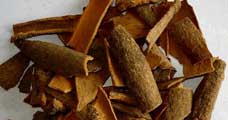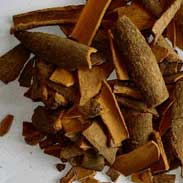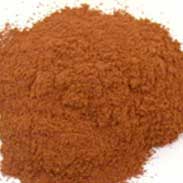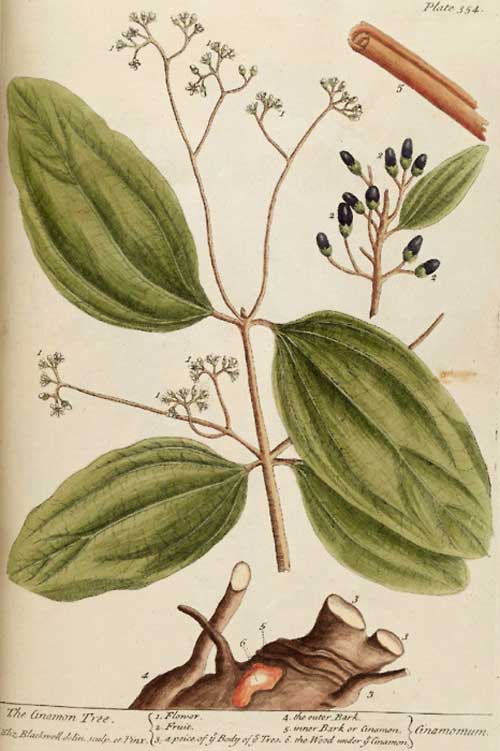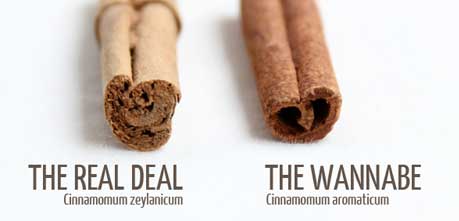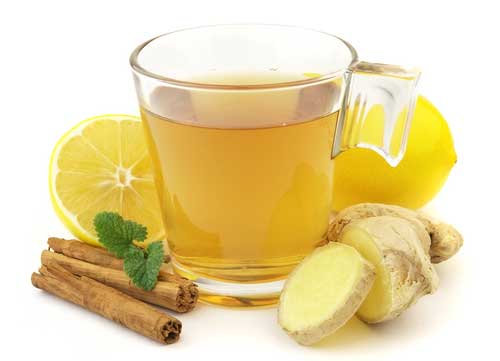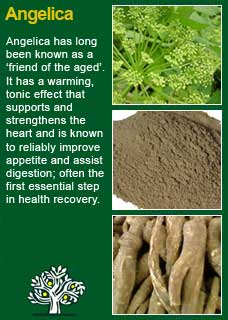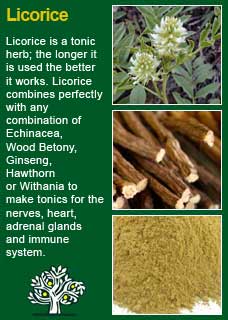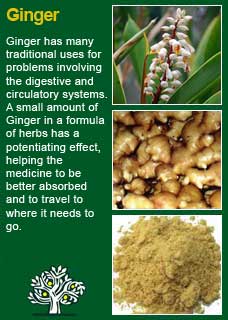
|
|
||||
| Our Pages ABOUT CONSTITUTIONAL MEDICINE
|
The inner bark of Cinnamon, a long-lived tree that grows up to 10 meters in height, is native to Sri Lanka but is now widely grown in South East Asia. M Grieve writes 'Cinnamon grows best in almost pure sand, requiring only 1 per cent of vegetable substance; it prefers a sheltered place, constant rain, heat and equal temperature. The tree grows from 20 to 30 feet high, has thick scabrous bark, strong branches, young shoots speckled greeny orange, the leaves petiolate, entire, leathery when mature, upper side shiny green, underside lighter; flowers small white in panicles; fruit, an oval berry like an acorn in its receptacle, bluish when ripe with white spots on it, bigger than a blackberry; the root-bark smells like cinnamon and tastes like camphor, which it yields on distillation. Leaves, when bruised, smell spicy and have a hot taste; the berry tastes not unlike Juniper and has a terebine smell; when ripe, bruised and boiled it gives off an oily matter which when cool solidifies and is called cinnamon suet. The commercial Cinnamon bark is the dried inner bark of the shoots. Cinnamon has a fragrant perfume, taste aromatic and sweet; when distilled it only gives a very small quantity of oil, with a delicious flavour' The history of Cinnamon is at least as spicy as its subject. Cinnamon was one of the most important of the prized spices that changed the path of Europe from the time of Marco Polo right up until the Colonial powers set forth to control the trade routes.
As a medicine, Cinnamon has been much used to help with ‘cold and debilitated’ conditions. People that habitually get tired and run down in the cold season would find that regularly taking Cinnamon stopped them getting sick and helped them to feel warmer. Cinnamon has a strong history of use in rapidly helping with excess bleeding, especially from the womb. Likewise, Cinnamon has traditionally been used for, diarrhoea, colic, excess flatulence, nausea or a slowed and weakened digestion. Avicenna, in his Canon of Medicine, one of the most influential medical books in history, writes of Cinnamon being markedly heating and drying and describes it as being 'highly attenuant (blood-thinning) , and cleansing. It is useful in cough and it clears chest congestion, it removes hepatic obstructions and strengthens liver and stomach'. He wrote that 'the oil of cinnamon is a wonderful drug for chorea' i.e. what we would today call 'involuntary movement disorders' TJ Lyle writes 'the inner bark of the branches is a warming, diffusive, stimulating, aromatic and astringent tonic. It is rich in oil, upon which its properties largely depend. It influences chiefly the gastro-intestinal mucous membrane, and is one of the best agents in cholera infantum, and in all cases of diarrhoea. But in all such cases care must be taken to keep the liver and gall ducts in proper action. It promotes digestion, soothes the nerves and stimulates the circulation, but it is mostly used as an adjuvant in the administering of other medicines' F Ellingwood writes 'this agent has long been used as a carminative and local gastric stimulant. It has a mild influence which is grateful and soothing. It has been used to check nausea and vomiting and to relieve flatulence. Midwives and nurses have long given a strong infusion of cinnamon to control postpartum hemorrhage, and it has been advised in “nose-bleed” and in flooding during miscarriage and in menorrhagia' H Felter writes extensively on Cinnamon early in the 20th century, including the following: 'Cinnamon imparts a flavor to unpleasant medicines and may be used to preserve them from rapid changes.Medicines dispensed in but few drops in a half glass of water will not keep sweet long at any time and will quickly sour in summer time. A few drops of Cinnamon added to such mixtures give an agreeable sweetness and aroma and will help the medicine to preserve its balance for several days. Cinnamon is an aromatic stimulant, carminative and astringent that possesses marked internal hemostatic power and that this is not wholly due to the tannin contained in the bark is shown by the prompt action of the tincture of the oil. Cinnamon has been proved in Eclectic practice to be a very important remedy in hemorrhages. The type of hemorrhage most benefited is the post-partum variety, though here it has its limitations. If the uterus is empty and the hemorrhage is due to flaccidity of that organ due to lack of contraction, then it becomes an important agent. Then it strongly aids the action of ergot and should be alternated with it. If retained products are the provoking cause of the bleeding, little can be expected of this or any other agent until the material has been expelled. In menorrhagia, even when due to fibroids and polyps, it has had the effect of intermittently checking the waste: but only a surgical operation is the rational course in such cases. Other hemorrhages of a passive type are benefited by cinnamon. Thus we have found it a very important agent in hemoptysis of severity (coughing up of blood). In such cases we have added it to specific medicine ergot and furnished it to the patient to keep on hand as an emergency remedy. By having the medicine promptly at hand the patient becomes less agitated or frightened, and this contributes largely to the success of the treatment. Rest and absolute mental composure on the part of the patient and the administration of cinnamon have been promptly effective. If not equal to the emergency, then a small hypodermatic injection of morphine and atropine sulphates will usually check the bleeding. When used with ergot in pulmonary hemorrhage probably more relief comes from the cinnamon than from the ergot, for ergot alone is far less effective. We are told that ergot does not act as well in pulmonary bleeding as in other forms of hemorrhage because of the sparse musculature and poor vaso-motor control of the pulmonic essels. But cinnamon has given results which have been entirely satisfactory. Hemorrhages from the stomach, bowels, and renal organs are often promptly checked by the timely administration of cinnamon' The British Herbal Pharmacopoeia (BHP) describes Cinnamon's actions as spasmolytic, carminative, orexigenic (appetite stimulant), antidiarrhoeal, antimicrobial, anthelmintic and says it is indicated for flatulent dyspepsia, anorexia, intestinal colic, infantile diarrhoea, common cold & influenza. The BHP recommends it combines well with Elder, Peppermint & Yarrow in the flu and with Marshmallow, Slippery Elm and Meadowsweet for gastritis & dyspepsia and suggests a dose of 0.5-1 gms of the extract in 70% ethanol.
~ There has been, in recent times, a great deal of interest into Cinnamon's biochemical activity in potentiating insulin with consequent potential for the treatment of diabetes and the metabolic disorder. Research suggests that cinnamon bark constituent, methylhydroxychalcone polymer (MHCP), might improve insulin sensitivity. It seems to mimic the activity of insulin, stimulating glucose metabolism. It also appears to work synergistically with insulin, possibly by improving insulin signaling pathways and alternative pathways that cause increased cellular glucose uptake. (Anderson RA, Broadhurst CL, Polansky MM, et al. Isolation and Characterization of Polyphenol Type-A Polymers from Cinnamon with Insulin-like Biological Activity. J Agric Food Chem 2004;52:65-70) ~ Further studies indicate that Cinnamon potentiates insulin activity by affecting protein phosphorylation in the intact fat cell; the insulin potentiating activity of cinnamon was not correlated with its total chromium content. (Khan a et al: Biol Trace Elem res 24(3):183-188, 1990) (Quale JM et al: Am J Chin Med 24(2):103-109, 1996) ~ In a clinical trial with diabetes, there was a significant decrease in levels of blood sugar, cholesterol and blood fats (Khan A, Safdar M, Khan, MMA, et al. Cinnamon improves glucose and lipids of people with type 2 diabetes. Diabetes Care 2003;26:32:3215-8) ~ Cinnamon oil has demonstrated antifungal and antibacterial properties in vitro, including activity against a range of dermatophytes (Lima EO et al: Mycoses 36(9-10):333-336, 1993). Cinnamic aldehydfe has been identified as an active fungitoxic constituent (Singh HB et al: Allergy 50(12):995-999, 1995) ~ Administration of cinnamon treatment for 1 week improved oral candidiasis in 5 patients with HIV infection (J. M., Landman, D., Zaman, M. M., Burney, S., and Sathe, S. S. In vitro activity of Cinnamomum zeylanicum against azole resistant and sensitive Candida species and a pilot study of cinnamon for oral candidiasis. Am J Chin Med 1996;24(2):103-109) ~ The authors, titles and the 'where-and-when' published of nearly 60 further studies and articles on Cinnamon are listed in a PDF found here
In a nutshell, I would say that for Cinnamon in food, beverages or as a usual herbal extract; no problem for any age, pregnancy, breastfeeding etc. However, Cinnamon as an essential oil or as a concentrate needs to be treated with a great deal of caution as there is a real and high possibility of allergic reactions of the skin or mucous membranes. This is most likely because of the cinnamic aldehyde which is known to be a potent contact sensitiser. Theoretically, cinnamon bark may lower blood glucose levels, and have additive effects in patients treated with antidiabetic agents; it should be used with with caution and dosage adjustments to diabetes medications might be necessary. Antidiabetes drugs include glimepiride (Amaryl), glyburide (DiaBeta, Glynase PresTab, Micronase), insulin, metformin (Glucophage), pioglitazone (Actos), rosiglitazone (Avandia), and others (Anderson RA, Broadhurst CL, Polansky MM, et al. Isolation and Characterization of Polyphenol Type-A Polymers from Cinnamon with Insulin-like Biological Activity. J Agric Food Chem 2004;52:65-70)
For some years now, against this proven and safe way of herbalism, there has been a rising tide of excessive caution and scare-mongering in many parts of the world. The same authorities that, not so long ago, decried herbal medicines as ineffectual, have now taken up a different adversarial position; that they are dangerous substances that should only be prescribed by Doctors, who of course have zero training in them. Unfortunately, the same unnecessary fear and worry has crept into many natural health websites and popular publications on herbs. Herbs that we have safely used for thousands of years, that have no reports of adverse reactions in the medical literature despite widespread use by millions of people, are suddenly described as contraindicated because of something that should have been seen as completely unimportant, or at the utmost a merely theoretical concern, such as a laboratory study on one of the herb's constituents to use an all too common example. I wonder sometimes if the writers of such articles feel that the herb will be more deserving of respect if it is thought to be a little bit dangerous, in other words more like a drug than something that has simply come out of the earth and been used by ordinary people for generations beyond count. There is just so much misinformation about herbal medicine on the internet now. Ludicrous claims and cautions abound in equal measure; it seems like one group are trying to make money out of the public whilst the other are busily trying to scare them off. I have to believe that the kind of reader who takes the time to read pages on herbs that are as extensive as this one is much less likely to be swayed by marketers or misinformers. I hope that you will keep your wits about you if you get conflicting opinions from people who have never really got to know these herbs, who have never worked with them, or learned how to use them safely and effectively. I want to remind you that the reason that herbs can never be patented and owned by any individual or corporation is because they are, and always will be, the People's medicine. They belong to all of us and it is my great hope in sharing this work that you will learn how to use them wisely for yourself, and the people you care for. Be safe, but do not be afraid.
An esteemed colleague wrote on our international online forum 'I have a number of patients with uncontrolled type 2 diabetes on multiple medications, and have seen their numbers drop with a tincture of Cinnamomum, Curcuma longa, and Berberis aquifolium' (Cinnamon, Turmeric & Barberry). A simple way to summarise the action of Cinnamon in this regard is that it 'enhances sugar uptake at insulin receptor sites' This is just one way to use Cinnamon. All herbalists ascribe a great deal of value to this common kitchen spice and I find that adding just a very small amount of Cinnamon extract into a herbal formula can have a remarkable effect on the treatment's ‘temperament’. Cinnamon helps the medicine to travel deeper into the body and at the same time it can effectively counter-balance a remedy that might otherwise turn out to be too cooling and/or cleansing. Another herbalist wrote on that same forum that 'the problem with using super cold medicinals, whether botanical or antibiotic, is that they damage the gut, ultimately furthering the problem. This is particularly true if there is a cold pattern behind the illness. If this is the case, then Cinnamon and Ginger are necessary agents' Anyone that wants to test this out for themselves and especially anyone who is studying herbal medicine could try taking a very small dose (e.g. a few sips of a Cinnamon tea or a few drops of its tincture) and then feel for themselves what happens next. If you do this with a quiet and attentive mind then I think the first thing you will notice is just how rapidly Cinnamon gets to work! It's almost as if it literally drops into your core without needing to go through a lot of processing beforehand. Once there you can readily feel the herbs 'action' i.e. what it is doing in your body. The kinds of words we use for this can only be a reflection of the feeling but if you are open to this kind of experiential learning then I expect you will soon know what is really meant about this herb when it is said 'warming, stimulating, nourishing'... Further to this, if you would like to learn more about the ancient art of pulse testing, a simple but powerful way to ask the intuitive intelligence of the body for its responses to a herb by feeling the pulse whilst giving a tiny dose by mouth, read here As a herbal medicine in its own right Cinnamon is ideal for people with 'cool' constitutions and adding some Cinnamon to the classic Ginger decoction (recipe below) provides a deep and lasting antidote to winter chills and common colds. In terms of dosage; subtle is the way with Cinnamon. I think you should just be able to smell and taste it but not so much that it dominates everything else. If you put too much cinnamon in a herbal medicine it is the same as putting too much into baking or cooking, what should be a pleasant, warming spice can quickly become overpowering if we are not careful. As an example, I would only use about 2.5-5% of Cinnamon extract in a formula, i.e. about 5-10mls in a 200ml bottle. Cinnamon works particularly well with Angelica in convalescence or fatigue. It combines with Licorice root for low immunity and reduced resistance to stress and it combines with Ginger to improve circulation and vitality.
The fresh Ginger along with Cinnamon makes this a medicine to use when you want to get a deep acting medicine into the blood and the bones.
~ 1 dsp well chopped Fresh Ginger Root (about as much as the last joint of your thumb) Break the small piece of cinnamon into a few pieces or use the fresh powder, add the chopped ginger and put together into a saucepan with approximately one and a half large cups of water. Bring the water to the boil then gently simmer for about 5 minutes until you have about one cup of the tea remaining. Take off the heat, squeeze in the 1/2 lemon and then strain through a sieve into a cup. Stir in the honey and drink whilst it is still hot. After a while you should notice a powerful feeling of warmth spreading through your body. People who find this decoction particularly beneficial can make larger amounts of the tea and put the extra in a thermos to drink later, especially on a cold damp days!
Much of the information here about the traditional uses of Cinnamon is consistent with the model of thinking whereby one may treat problem A with plant B. There is value in this approach, especially in how it helps us pass on useful knowledge to one another, but it falls short in one vital area; and that is that people are not all cut from the same cloth! Something that works brilliantly for one person may do less for another -- why is this? Part of the reason is that people vary in their constitutions as to whether they are either hotter or cooler and, at the same time, either dryer or damper. This useful and rather fascinating subject is introduced further here Another big part of using the right herb when it is most needed comes from understanding the need to treat what is going wrong for the person that had led up to their getting a health condition. In this light, Cinnamon can particularly offer its benefits when an activation is needed in the 'cycle of healing', more about this here
Please understand that I cannot advise you, including on products or dosage, without seeing you in person in my clinic but for ideas
on how you might find a good herbalist in your area read here |
|
|
© 2011 R.J.Whelan Ltd
